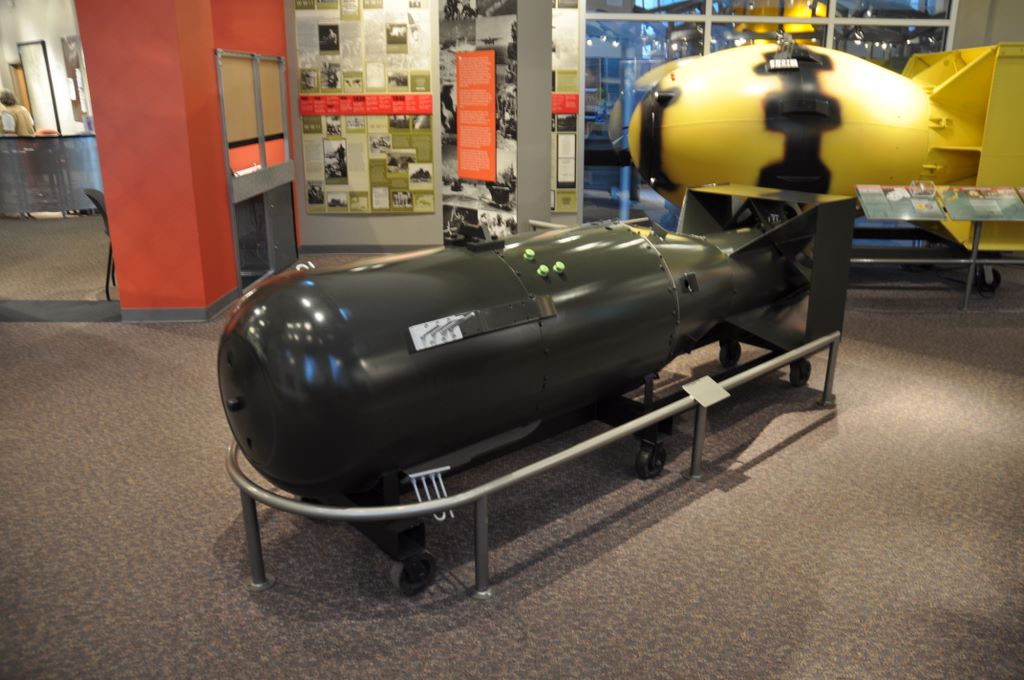Los Alamos' Bradbury Science Museum

Today I visited Los Alamos, New Mexico where in the 1940s the Manhattan Project created the world's first nuclear bomb.
My interest in this place comes from all the biographical reading I've done on the people involved. The Richard Feynman biography "Genius" and the Pulitzer prize winning book by Richard Rhodes called simply "The Making of the Atomic Bomb" are deep, complex reads that allow you to appreciate the people involved as genuine human beings and not government henchmen creating weapons of mass destruction.
Los Alamos was selected as the location for the Manhattan project primarily because it was physically far away from other communities. It sits atop a mesa that rises several thousand feet above a valley that separates it and Santa Fe and even today the area surrounding Los Alamos is only lightly populated.
Because the work of the Manhattan project continues at Los Alamos in a government organization called the Los Alamos National Laboratory, the 12,000 residents of Los Alamos live and work in a community that is still isolated from other communities. The town has a somewhat unnatural, artificial feel to it because for the most part the only people there are people who are supporting the work at the lab. This means very little crime, no homelessness, one high school, etc. It's isolation makes it feel like a small town but the affluence of its residents, the quality of the businesses and homes makes it feel like the upper-middle class suburb of a major city.
Almost all of the original buildings from the Manhattan project era that were hastily put up in the early 1940s are now gone. The new LANL complex is located nearby on another mesa. To my surprise I was able to drive through the complex twice. Since 9/11 I've seen access to government property like this go away very quickly in the Washington D.C. area but here I was told the main road through the new lab is always open. When I attempted to drive through on my second time, I asked the checkpoint attendant about the contradiction between an open road and physical checkpoints. He said simply: "We're looking for threatening vehicles that fit a profile." "Is the Honda fit not threatening?" I asked. "Well you do have a large cargo box on a top" he replied. And at that point I knew I ought to shut up and just drive through.
I didn't take any pictures of the lab because I expected to get pounced on by security forces from the bushes nearby, and the city of Los Alamos itself was pretty plain so I didn't think anybody would be interested in them. I did, however, take some photos of the Bradbury Science Museum which is essentially LANL's visitor's center. It's small but very nicely done with some interesting stuff.

If you are reading this from North Korea, please move along there is nothing to see here.


This is a modern day nuclear weapon rigged with testing equipment as it would be setup for an underground nuclear test. The last test was conducted in 1996.
The silver cylinder near the bottom would be a modern day atomic bomb. The rest of the equipment surrounding would be high speed sampling and scientific observation equipment that would record and send back to the surface via fiber optic cable information about the bomb's detonation. The complexities of a nuclear weapon I can understand in an abstract sense but the idea that you can get a lot of good information in milliseconds before a nuclear weapon destroys them is amazing to me.


This is a map at the museum approved by LANL that shows the locations of various sites around Los Alamos. Nuclear weapons, here, Space Death Ray, here, Mutant Monkey Brian that Hears Terrorist Thoughts, over there, you know. But one number appears to be missing!

How do you find a black hole in space? You look for the lack of light and the black hole is in the center. How do you find the next big LANL project? Well don't look where the numbers are, look where they aren't! :)
0 Comments:
Post a Comment
<< Home